William Tecumseh Sherman
 From Nwe
From Nwe
William Tecumseh Sherman (February 8, 1820 – February 14, 1891) was an American soldier, businessman, educator, and author. He served as a general in the United States Army during the American Civil War (1861–65), receiving both recognition for his outstanding command of military strategy and criticism for the harshness of the "scorched earth" policies he implemented in conducting total war against the enemy. Military historian Basil Liddell Hart famously declared that Sherman was "the first modern general." (Liddell Hart 1993, 430)
Sherman's attack on civilian infrastructure and displacement of thousands of southerners set a precedent for later, even more destructive campaigns in the twentieth century. Yet his southern strategy turned the tide of war and greatly influenced the reelection of President Abraham Lincoln. Within months of the election, on April 9, 1865, Confederate General Robert E. Lee surrendered to Union General Ulysses S. Grant at Appomattox Court House in Virginia, ending the Confederacy. The complete abolition of slavery in the United States would follow within a year with the passage of the Thirteenth Amendment to the U.S. Constitution.
After the Civil War, Sherman became Commanding General of the Army from 1869 to 1883. As such, he was responsible for the conduct of the Indian Wars in the western United States, again winning both praise for his military effectiveness and blame for his ruthless strategy of "total war." He steadfastly refused to be drawn into politics and in 1875 published his Memoirs, one of the best-known firsthand accounts of the Civil War. In 1884, Sherman turned down an opportunity to run for the presidency, living out his life in New York City.
Early life
Sherman was born Tecumseh Sherman, named after the famous Shawnee leader, in Lancaster, Ohio, near the shores of the Hocking River. His father, Charles Robert Sherman, was a successful lawyer who sat on the Ohio Supreme Court. Judge Sherman died suddenly in 1829, leaving his widow, Mary Hoyt Sherman, with eleven children and no inheritance. Following this tragedy, the nine-year-old Tecumseh was raised by a Lancaster neighbor and family friend, attorney Thomas Ewing, a prominent member of the Whig Party who served as senator from Ohio and as the first Secretary of the Interior. Sherman was also distantly related to the very powerful Baldwin, Hoar, and Sherman families of United States politicians, and was said to be a great admirer of American founding father Roger Sherman.[1]
Senator Ewing secured the appointment of the 16-year-old Sherman as a cadet in the United States Military Academy at West Point. (Sherman 1990, 14) There Sherman excelled academically, but treated the demerit system with indifference. Fellow cadet and later Civil War General William Rosecrans would later remember Sherman at West Point as "one of the brightest and most popular fellows," and "a bright-eyed, red-headed fellow, who was always prepared for a lark of any kind." (Hirshson 1997, 13)
Upon graduation in 1840, Sherman entered the Army as a second lieutenant in the 3rd U.S. Artillery and saw action in Florida in the Second Seminole War. He was later stationed in Georgia and South Carolina. As the foster son of a prominent Whig politician, the popular Lt. Sherman moved within the upper circles of Old South society in Charleston. (Hirshson 1997, 21)
While many of his colleagues saw action in the Mexican-American War, Sherman performed administrative duties in the captured territory of California. He and fellow officer Lt. Edward Ord reached the town of Yerba Buena two days before its name was changed to San Francisco. In 1848, Sherman accompanied the military governor of California, Col. Richard Barnes Mason, in the inspection that officially confirmed the claim that gold had been discovered in the region, thus inaugurating the California Gold Rush. Sherman earned a promotion to captain for his "meritorious service," but his lack of a combat assignment discouraged him and may have contributed to his decision to resign his commission. Sherman would become one of the relatively few high-ranking officers in the Civil War who had not fought in Mexico.
Marriage and business career
In 1850, Sherman married the Ewing's daughter, Eleanor Boyle ("Ellen") Ewing. Ellen was, like her mother, a devout Catholic and their eight children were raised in that faith. To Sherman's great displeasure, one of his sons, Thomas Ewing Sherman, was ordained a Jesuit priest in 1879. (Hirshson 1997, 362–368, 387)
In 1853, Sherman resigned his military commission and became president of a bank in San Francisco. He survived two shipwrecks and floated through the Golden Gate on the overturned hull of a foundering lumber schooner. (Sherman 1990, 125–129) He returned to San Francisco at a time of great turmoil in the West. Sherman's bank failed during the financial Panic of 1857 and he turned to the practice of law in Leavenworth, Kansas, at which he was also unsuccessful. (Sherman 1990, 158–160) Sherman eventually suffered from stress-related asthma because of the city's brutal financial climate.
In 1859 Sherman accepted a job as the first superintendent of the Louisiana State Seminary of Learning and Military Academy in Pineville, a position offered to him by Major D. C. Buell and General G. Mason Graham. (Sherman 1990, Chap. VI) He proved an effective and popular leader of that institution, which would later become Louisiana State University (LSU). Colonel Joseph P. Taylor, the brother of the late President Zachary Taylor, declared that "if you had hunted the whole army, from one end of it to the other, you could not have found a man in it more admirably suited for the position in every respect than Sherman." (Hirshson 1997, 68)
In January 1861 just before the outbreak of the American Civil War, Sherman was required to accept the receipt of arms surrendered to the State Militia by the U.S. Arsenal at Baton Rouge. Instead of complying, he resigned his position as superintendent and returned to the North, declaring to the governor of Louisiana, "On no earthly account will I do any act or think any thought hostile … to the … United States."[2] He subsequently became president of the St. Louis Railroad, a streetcar company, a position he held for only a few months before being called to Washington, D.C. to take up a commission.
Civil War service

Bull Run and Louisville
After the outbreak of the Civil War, Sherman accepted a commission as a colonel in the 13th U.S. Infantry regiment on May 14, 1861. He was one of the few Union officers to distinguish himself at the First Battle of Bull Run on July 21, where he was grazed by bullets in the knee and shoulder. The disastrous Union defeat led Sherman to question his own judgment as an officer and the capacities of his volunteer troops. President Lincoln, however, promoted him to brigadier general of volunteers (effective May 17, which ranked him senior to that of Ulysses S. Grant, his future commander). (Hirshson 1997, 90–94) He was assigned to command the Department of the Cumberland in Louisville, Kentucky.
During his time in Louisville, Sherman became increasingly pessimistic about the outlook of the war and repeatedly made estimates of the strength of the rebel forces that proved exaggerated, causing the local press to describe him as "crazy." In the fall of 1861, Sherman experienced what would probably be described today as a nervous breakdown. He was put on leave and returned to Ohio to recuperate, being replaced in his command by Don Carlos Buell.
Grant and Shiloh
However, Sherman quickly recovered and returned to service under Maj. Gen. Henry W. Halleck, commander of the Department of the Missouri. Halleck's department had just won a major victory at Fort Henry, but he harbored doubts about the commander in the field, Brig. Gen. Ulysses S. Grant, and his plans to capture Fort Donelson. Unknown to Grant, Halleck offered several officers, including Sherman, command of Grant's army. Sherman refused, saying he preferred serving under Grant, even though he outranked him.
After Grant was promoted to major general in command of the District of West Tennessee, Sherman served briefly as his replacement in command of the District of Cairo. He got his wish of serving under Grant when he was assigned on March 1, 1862, to the Army of West Tennessee as commander of the 5th Division. (Eicher and Eicher 2001, 485) His first major test under Grant was at the Battle of Shiloh.
The massive Confederate attack on the morning of April 6 took most of the senior Union commanders by surprise. Sherman had dismissed intelligence reports from militia officers, refusing to believe that Confederate General Albert Sidney Johnston would leave his base at Corinth. He took no precautions beyond strengthening his picket lines. Sherman would have wished to avoid appearing overly alarmed in order to escape the kind of criticism he had received in Kentucky.
Despite being caught unprepared by the attack, Sherman rallied his division and conducted an orderly, fighting retreat that helped avert a disastrous Union rout. He would prove instrumental to the successful Union counterattack of April 7. Sherman was wounded twice—in the hand and shoulder—and had three horses shot out from under him. His performance was praised by Grant and Halleck. After the battle he was promoted to major general of volunteers, effective May 1. (Eicher and Eicher 2001, 485)
Vicksburg and Chattanooga
Sherman developed close personal ties to Grant during the two years they served together. Shortly after Shiloh, Sherman persuaded Grant not to resign from the Army, despite the serious difficulties he was having with his commander, General Halleck. Sherman later famously declared that "Grant stood by me when I was crazy and I stood by him when he was drunk, and now we stand by each other always." (Brockett 1866, 175)
Sherman's military record in 1862–63 was mixed. In December 1862, forces under his command suffered a severe repulse at the Battle of Chickasaw Bluffs, just north of Vicksburg. Soon after, his XV Corps was ordered to join Maj. Gen. John A. McClernand in his successful assault on Arkansas Post.
In November at the third Battle of Chattanooga, Sherman, now in command of the Army of the Tennessee, quickly engaged his assigned target of Billy Goat Hill at the north end of Missionary Ridge, only to discover that it was not part of the ridge at all, but rather a detached spur separated from the main spine by a rock-strewn ravine. When he attempted to attack the main spine at Tunnel Hill, his troops were repeatedly repulsed. Sherman's effort was overshadowed by George Henry Thomas's army's successful assault on the center of the Confederate line, a movement originally intended as a diversion.
Georgia
Despite this mixed record, Sherman enjoyed Grant's confidence and friendship. When President Lincoln called Grant east in the spring of 1864 to take command of all the Union armies, Grant appointed Sherman (by then known to his soldiers as "Uncle Billy") to succeed him as head of the Military Division of the Mississippi, which entailed command of Union troops in the Western Theater of the war. As Grant took command of the Army of the Potomac, Sherman wrote to him outlining his strategy to bring the war to an end, concluding that "if you can whip Bobby Lee and I can march to the Atlantic I think ol' Uncle Abe will give us twenty days leave to see the young folks." (Sherman 1990, 589)
Sherman proceeded to invade the state of Georgia with three armies: The 60,000–strong Army of the Cumberland under George Henry Thomas, the 25,000–strong Army of the Tennessee under James B. McPherson, and the 13,000–strong Army of the Ohio under John M. Schofield. He fought a lengthy campaign maneuvering through the mountainous terrain against Confederate General Joseph E. Johnston's Army of Tennessee, attempting a direct assault against Johnston only at the disastrous Battle of Kennesaw Mountain. The cautious Johnston was replaced by the more aggressive John Bell Hood, who played to Sherman's strength by challenging him to direct battles on open ground.
Sherman's Atlanta Campaign concluded successfully on September 2, 1864, with the capture of the city of Atlanta, an accomplishment that made Sherman a household name in the North and helped ensure Lincoln's presidential re-election in November. Before this success, Lincoln's electoral defeat by Democratic Party candidate George B. McClellan, the former Union army commander, had appeared likely in the summer of that year. Such an outcome may have meant the victory of the Confederacy, as the Democratic Party platform called for peace negotiations, based on the acknowledgment of the Confederacy's independence. Thus the capture of Atlanta, coming when it did, may have been Sherman's greatest contribution to the Union cause.
After Atlanta, Sherman dismissed the impact of Confederate General Hood's attacks against his supply lines and sent George Thomas and the Army of the Cumberland to defeat him in the Franklin-Nashville Campaign. Meanwhile, declaring that he could "make Georgia howl,"[3] Sherman marched with 62,000 men to the port of Savannah, living off the land and causing, by his own estimate, more than $100 million in property damage.[4] At the end of this campaign, known as Sherman's March to the Sea, his troops captured Savannah on December 22, 1864. Sherman then telegraphed Lincoln, offering him the city as a Christmas present.
The Carolinas
In the spring of 1865, Grant ordered Sherman to embark his army on steamers to join him against Lee in Virginia. Instead, Sherman persuaded Grant to allow him to march north through the Carolinas, destroying everything of military value along the way, as he had done in Georgia. He was particularly interested in targeting South Carolina, the first state to secede from the Union, for the effect it would have on Southern morale. His army proceeded north through South Carolina against light resistance from the troops of Confederate General Joseph E. Johnston.
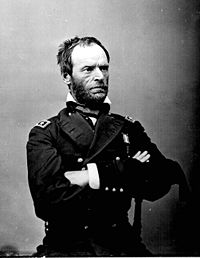
Sherman captured the state capital of Columbia on February 17, 1865. Fires began in Columbia that night and by the next morning, most of the central city was destroyed. The burning of Columbia has engendered controversy ever since, with some claiming the fires were accidental, others a deliberate act of vengeance, and still others that the retreating Confederates burned bales of cotton on their way out of town. Thereafter, his troops did little damage to the civilian infrastructure.
Shortly after his victory over Johnston's troops at the Battle of Bentonville, Sherman met with Johnston at Bennett Place in Durham, North Carolina, to negotiate a Confederate surrender. At the insistence of Johnston and Confederate President Jefferson Davis, Sherman offered generous terms that dealt with both political and military issues, despite having no authorization to do so from either Grant or the cabinet. The government in Washington, D.C. refused to honor the terms, precipitating a long-lasting feud between Sherman and Secretary of War Edwin M. Stanton. Confusion over this issue lasted until April 26, when Johnston, ignoring instructions from President Davis, agreed to purely military terms and formally surrendered his army and all the Confederate forces in the Carolinas, Georgia, and Florida.[5]
Slavery and emancipation
Though he came to disapprove of slavery, Sherman was not an abolitionist before the war, and like many of his time and background, he did not believe in "Negro equality."[6] However, his military campaigns of 1864 and 1865 freed many slaves, who greeted him "as a second Moses or Aaron" (Simpson 1999, 794–795) and joined his marches through Georgia and the Carolinas by the tens of thousands. The precarious living conditions and uncertain future of the freed slaves quickly became a pressing issue.
On January 16, 1865, Sherman issued his Special Field Orders, No. 15, providing for the settlement of 40,000 freed slaves and black refugees on land expropriated from white landowners in South Carolina, Georgia, and Florida. Sherman appointed Brigadier General Rufus Saxton, an abolitionist from Massachusetts who had previously directed the recruitment of black soldiers, to implement that plan.[7] Those orders, which became the basis of the claim that the Union government had promised freed slaves "40 acres and a mule," were revoked later that year by President Andrew Johnson.
Strategies
Although General Sherman's record as a tactician was mixed, he left an important military legacy based on his command of logistics and his brilliance as a strategist. The influential, twentieth-century British military historian and theorist Basil Liddell Hart ranked Sherman as one of the most important strategists in the annals of war, along with Scipio Africanus, Belisarius, Napoleon Bonaparte, T. E. Lawrence, and Erwin Rommel. Liddell Hart credited Sherman with mastery of maneuver warfare (also known as the "indirect approach"), as demonstrated by his series of turning movements against Johnston during the Atlanta Campaign. Liddell Hart also stated that study of Sherman's campaigns had contributed significantly to his own "theory of strategy and tactics in mechanized warfare," which had in turn influenced Heinz Guderian's doctrine of Blitzkrieg and Rommel's use of tanks during World War II.[8]
Sherman's greatest contribution to the war, the strategy of total warfare—endorsed by General Grant and President Lincoln—has been the subject of much controversy. Sherman himself downplayed his role in conducting total war, often saying that he was simply carrying out orders as best he could in order to fulfill his part of Grant's master plan for ending the war.
Postbellum service
On July 25, 1866, Congress created the rank of general of the army for Grant and promoted Sherman to lieutenant general. When Grant became president in 1869, Sherman was appointed to Grant's former post. He also served for one month as interim Secretary of War. His tenure as commanding general was marred by political difficulties, and from 1874 to 1876 he moved his headquarters to St. Louis, Missouri in an attempt to escape them. One of his significant contributions as head of the Army was the establishment of the Command School (now the Command and General Staff College) at Fort Leavenworth.
Sherman's main concern as commanding general was to protect the construction and operation of the railroads from attack by hostile Indians. In his campaigns against the Indian tribes, Sherman repeated his Civil War strategy by seeking not only to defeat the enemy's soldiers, but also to destroy the resources that allowed the enemy to sustain its warfare. The policies he implemented included the decimation of the buffalo, which were the primary source of food for the Plains Indians. (Isenberg 2000, 128, 156) Despite his harsh treatment of the warring tribes, Sherman spoke out against speculators and government agents who treated the natives unfairly within the reservations. (Lewis and Simpson 1993, 597–600)
In 1875 Sherman published his memoirs in two volumes. On June 19, 1879, he delivered his famous "War Is Hell" speech to the graduating class of the Michigan Military Academy and to the gathered crowd of more than 10,000: "There is many a boy here today who looks on war as all glory, but, boys, it is all hell."[9]
Sherman stepped down as commanding general on November 1, 1883, and retired from the army on February 8, 1884. He lived most of the rest of his life in New York City. He was devoted to the theater and to amateur painting and was much in demand as a colorful speaker at dinners and banquets, in which he indulged a fondness for quoting William Shakespeare.[10] Sherman was proposed as a Republican candidate for the presidential election of 1884, but declined as emphatically as possible, saying, "If nominated I will not run; if elected I will not serve." (Heidler et al. 2000, 1769) Such a categorical rejection of a candidacy is now referred to as a "Shermanesque statement."
Death and posterity
Sherman died in New York City on February 14, 1891. On February 19, a small funeral was held there at his home. His body was then transported to St. Louis, where another service was conducted on February 21 at a local Roman Catholic church. His son, Thomas Ewing Sherman, a Jesuit priest, presided over his father's funeral mass.
Sherman is buried in Calvary Cemetery in St. Louis. Major memorials to Sherman include the gilded bronze equestrian statue by Augustus Saint-Gaudens at the main entrance to Central Park in New York City and the major monument[11] by Carl Rohl-Smith near President's Park in Washington, D.C. Other posthumous tributes include the naming of the World War II M4 Sherman tank and the "General Sherman" Giant Sequoia tree, the most massive, documented, single-trunk tree in the world.
Writings
- General Sherman's Official Account of His Great March to Georgia and the Carolinas, from His Departure from Chattanooga to the Surrender of General Joseph E. Johnston and Confederate Forces under His Command (1865)
- Memoirs of General William T. Sherman, Written by Himself (1875)
- Reports of Inspection Made in the Summer of 1877 by Generals P. H. Sheridan and W. T. Sherman of Country North of the Union Pacific Railroad (co-author, 1878)
- The Sherman Letters: Correspondence between General and Senator Sherman from 1837 to 1891 (posthumous, 1894)
- Home Letters of General Sherman (posthumous, 1909)
- General W. T. Sherman as College President: A Collection of Letters, Documents, and Other Material, Chiefly from Private Sources, Relating to the Life and Activities of General William Tecumseh Sherman, to the Early Years of Louisiana State University, and the Stirring Conditions Existing in the South on the Eve of the Civil War (posthumous, 1912)
- The William Tecumseh Sherman Family Letters (posthumous, 1967)
- Sherman at War (posthumous, 1992)
- Sherman's Civil War: Selected Correspondence of William T. Sherman, 1860 – 1865 (posthumous, 1999)
Notes
- ↑ See William T. Sherman papers, Notre Dame University CSHR 19/67 Folder: Roger Sherman's Watch 1932–1942.
- ↑ Letter by W. T. Sherman to Gov. Thomas O. Moore, Jan. 18, 1861. In Sherman, Memoirs, p. 156.
- ↑ Telegram by W. T. Sherman to Gen. U. S. Grant, Oct. 9, 1864, reproduced in Simpson, Sherman's Civil War, pp. 731–732.
- ↑ Report by Maj. Gen. W. T. Sherman, Jan. 1, 1865, quoted in Grimsley, The Hard Hand of War, p. 200.
- ↑ Johnston's Surrender at Bennett Place on Hillsboro Road, Johnston's Surrender. Retrieved April 2, 2007.
- ↑ Letter by W. T. Sherman to Salmon P. Chase, Jan. 11, 1865, reproduced in Simpson, Sherman's Civil War, pp. 794–795, and letter by W. T. Sherman to John Sherman, Aug. 1865, quoted in Liddell Hart, Sherman: Soldier, Realist, American, p. 406.
- ↑ Special Field Orders, No. 15, Order by the Commander. Retrieved April 2, 2007.
- ↑ Liddell Hart, foreword to the Indiana University Press's edition of Sherman's Memoirs (1957). Quoted in Wilson, Patriotic Gore, p. 179.
- ↑ Ohio State Journal, August 12, 1880, reproduced in Lewis and Simpson, Sherman: Fighting Prophet, p. 637.
- ↑ See, for instance, Woodward, Civil Warriors.
- ↑ Monument in Sherman Square
References
ISBN links support NWE through referral fees
- Brockett, L. P. 1866. Our Great Captains: Grant, Sherman, Thomas, Sheridan, and Farragut. C. B. Richardson.
- Conrad, Glenn. 1988. A Dictionary of Louisiana Biography, "William Tecumseh Sherman." Louisiana Historical Association, Vol. II, p. 741. ISBN 978-0940984370
- Eicher, John H. and David J. Eicher. 2001. Civil War High Commands. Stanford University Press. ISBN 0-8047-3641-3
- Grimsley, Mark. 1997. The Hard Hand of War: Union Military Policy toward Southern Civilians, 1861–1865. Cambridge University Press. ISBN 0-521-59941-5
- Hanson, Victor D. 1999. The Soul of Battle. Anchor Books. ISBN 0-385-72059-9
- Heidler, David S. et al., eds. 2000. Encyclopedia of the American Civil War: A Political, Social, and Military History. W. W. Norton and Company. ISBN 0-393-04758-X
- Hirshson, Stanley P. 1997. The White Tecumseh: A Biography of General William T. Sherman. John Wiley and Sons. ISBN 0-471-28329-0
- Hitchcock, Henry. [1927] 1995. Marching with Sherman: Passages from the Letters and Campaign Diaries of Henry Hitchcock, November 1864 – May 1865, ed. M. A. DeWolfe Howe. University of Nebraska Press. ISBN 0-8032-7276-6
- Isenberg, Andrew C. 2000. The Destruction of the Bison. Cambridge University Press ISBN 0-521-00348-2
- Lewis, Lloyd and Brooks D. Simpson. [1932] 1993. Sherman: Fighting Prophet. University of Nebraska Press. ISBN 0-8032-7945-0
- Liddell Hart, Basil Henry. [1929] 1993. Sherman: Soldier, Realist, American. Da Capo Press. ISBN 0-306-80507-3
- Marszalek, John F. 1992. Sherman: A Soldier's Passion for Order. Free Press. ISBN 0-02-920135-7
- Royster, Charles. 1991. The Destructive War: William Tecumseh Sherman, Stonewall Jackson, and the Americans. Alfred A. Knopf. ISBN 0-679-73878-9
- Sherman, William T. [1889, 1913] 1990. Memoirs of General W. T. Sherman, 2nd ed. Library of America. ISBN 0-940450-65-8
- Simpson, B. D. 1999. Sherman's Civil War: Selected Correspondence of William T. Sherman, 1860–1865. University of North Carolina Press. ISBN 0-8078-2440-2
- Smith, Jean Edward. 2001. Grant. Simon and Shuster. ISBN 0-684-84927-5
- Warner, Ezra J. 1964. Generals in Blue: Lives of the Union Commanders. LSU Press. ISBN 0-8071-0822-7
- Wilson, Edmund. [1962] 1994. Patriotic Gore: Studies in the Literature of the American Civil War, Farrar, Straus and Giroux. Reprinted by W. W. Norton and Co. ISBN 0-393-31256-9
- Woodward, C. Vann. Civil warriors. New York Review of Books 37(17) (November 8, 1990).
External links
All links retrieved October 10, 2020.
- U.S. Army Center of Military History. army.mil.
- William Tecumseh Sherman, from the Virtual Museum of the City of San Francisco], sfmuseum.net.
- Sherman House Museum, shermanhouse.org.
- Memoirs of General W. T. Sherman. sonofthesouth.net.
- Works by William Tecumseh Sherman. Project Gutenberg.
Credits
New World Encyclopedia writers and editors rewrote and completed the Wikipedia article in accordance with New World Encyclopedia standards. This article abides by terms of the Creative Commons CC-by-sa 3.0 License (CC-by-sa), which may be used and disseminated with proper attribution. Credit is due under the terms of this license that can reference both the New World Encyclopedia contributors and the selfless volunteer contributors of the Wikimedia Foundation. To cite this article click here for a list of acceptable citing formats.The history of earlier contributions by wikipedians is accessible to researchers here:
The history of this article since it was imported to New World Encyclopedia:
Note: Some restrictions may apply to use of individual images which are separately licensed.
↧ Download as ZWI file | Last modified: 02/04/2023 12:53:17 | 2 views
☰ Source: https://www.newworldencyclopedia.org/entry/William_Sherman | License: CC BY-SA 3.0
 ZWI signed:
ZWI signed: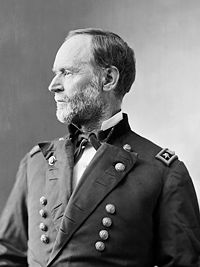
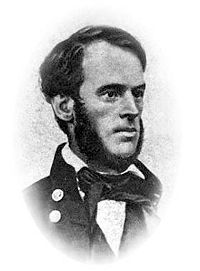
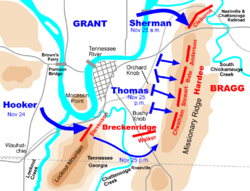
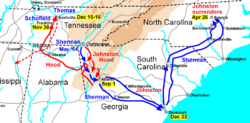
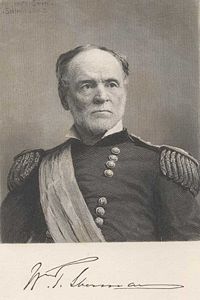
 KSF
KSF